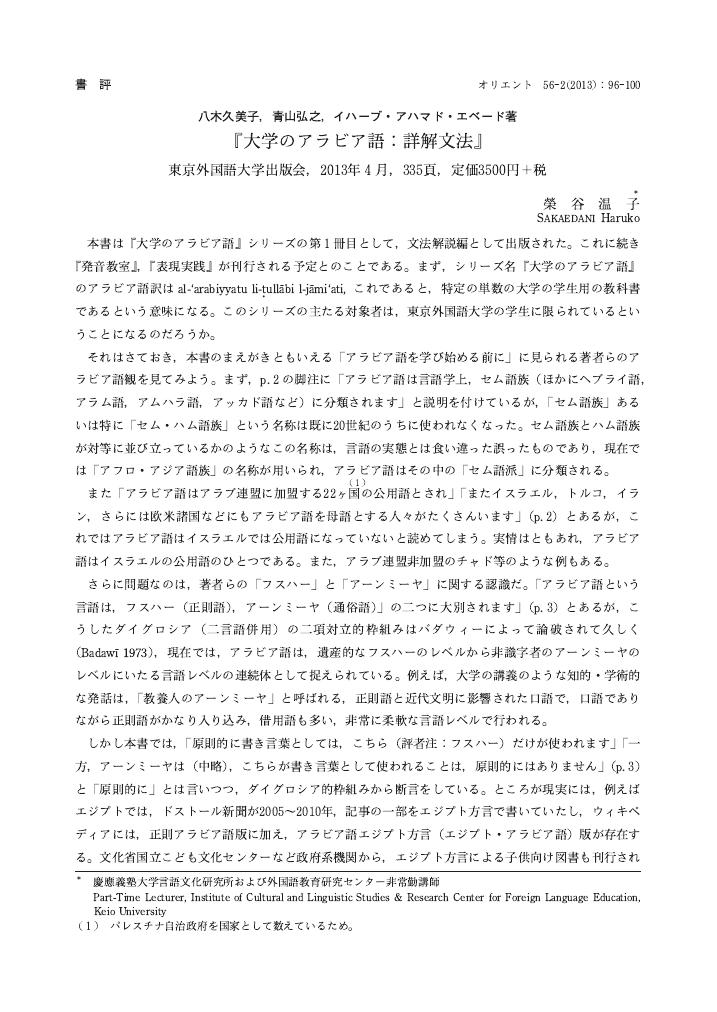- 著者
- 榮谷 温子
- 出版者
- 一般社団法人 日本オリエント学会
- 雑誌
- オリエント (ISSN:00305219)
- 巻号頁・発行日
- vol.56, no.2, pp.96-10, 2014-03-31 (Released:2017-04-03)
- 参考文献数
- 3
- 著者
- 榮谷 温子
- 出版者
- 日本中東学会
- 雑誌
- 日本中東学会年報 (ISSN:09137858)
- 巻号頁・発行日
- vol.12, pp.329-363, 1997-03-31 (Released:2018-03-30)
- 著者
- 榮谷 温子
- 出版者
- 日本中東学会
- 雑誌
- 日本中東学会年報 (ISSN:09137858)
- 巻号頁・発行日
- no.13, pp.257-285, 1998-03-31
本文中で触れたように、象は、パン屋さんで世界一巨大なカアク、お皿工場で普通のお皿の百枚分もある大皿、靴屋さんで百足分もある靴を作り、そのことは既に先行するテキストで述べられている。つまりこれらは全て限定形で表されていても、読者は文脈的情報によりその指示対象を理解できるはずもので、その原則に従えば限定形で表されるべきなのである。それがカアクだけが限定形で、お皿と靴が非限定形という不揃いが生じている。この場合まずカアクが限定形になっていることから、読者はその指示対象を知るためには、それ以前のテキストをスキャンし、象がパン屋さんで世界一大きなカアクを焼いたという情報を得る必要がある。ところが前節でも述べたように「象」の物語には、パターンの定まったサブ物語が3つあり、象はそのパターンに従ってそれぞれの巨大商品を作ったわけである。もし続くお皿と靴も限定形であったなら、カアクの場合と同じ情報検索の手間をさらに二回繰り返さなければならないことになる。加えてカアク・お皿・靴それぞれに修飾節が後続し、読者はそれらによっても情報を与えられている。この場合、最初のカアクだけを限定形にし、後の二つを非限定形すなわち読者の持っている情報ではその指示対象を特定できない場合の形式を用いて表すことで、逆に読者が情報検索、それも最初の情報検索と全く同じパターンの情報を得るための検索作業に用いる労力を省く効果があるのではないか。つまり最初だけ完全な形で提示し、二・三番目はいわば「以下同文」的な扱いをしたのである。さらに、こうして名詞句全体を"軽く"しておくことで、後に修飾節をつけて読者に別の情報を与えることが、よりやりやすくなった。或いは逆に、非限定形にして、その指示対象を特定するための情報を減らしてしまった分を、新たな修飾節で補ったと考えることもできるかもしれない。
1 0 0 0 IR 日本で刊行されているアラビア文字入門書 : アラビア文字教育に関する一考察
- 著者
- 榮谷 温子
- 出版者
- 慶應義塾大学外国語教育研究センター
- 雑誌
- 慶應義塾外国語教育研究
- 巻号頁・発行日
- no.14, pp.43-55, 2017
はじめにI. アラビア文字を紹介している書籍II. 文字の連なりを単語として認識することIII. 合字等の問題おわりに研究ノート
1 0 0 0 OA 情報構造としての限定・非限定
- 著者
- 榮谷 温子
- 出版者
- 一般社団法人 日本オリエント学会
- 雑誌
- オリエント (ISSN:00305219)
- 巻号頁・発行日
- vol.42, no.2, pp.40-60, 1999 (Released:2010-03-12)
- 参考文献数
- 9
In this study definiteness is considered in view of information structures, especially giving weight to the notion of “familiarity.” We compare it with three other information structures: old- and new-information, theme and rheme, and reference. Through this comparison we find that the category of definiteness is independent from the other structures, although it correlates with them.a) Old- and new-information is “already activated” and “unactivated” information in certain discourse but definiteness depends on a writer/speaker's assumptions.b) Theme-rheme structure is strategy on the sentence level though definiteness is on the noun phrase level.c) Referentiality means how a noun phrase refers (or does not refer) to an entity, though definiteness is the relation between a noun phrase and what it refers to.Then, this paper analyses the Egyptian short play 'Arafa Kayfa Yamutu by T. al-Hakim to show how definite noun phrases are used in discourse, and we found that the following features decide the usage of definite noun phrases:1) how much the speaker feels convinced of an issue, and2) how much the speaker puts importance on the object.The result tells us that the structure of definiteness and indefiniteness is not only defined through hearers' or readers' state, but also that definiteness can be employed actively or subjectively by the speaker/writer. Definiteness is one independent information structure and a device which can be used actively by writers/speakers to send their message to others.
- 著者
- 榮谷 温子
- 出版者
- 外国語教育学会
- 雑誌
- 外国語教育研究 (ISSN:13487639)
- 巻号頁・発行日
- no.7, pp.17-32, 2004

